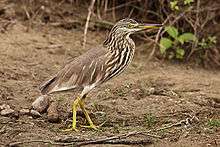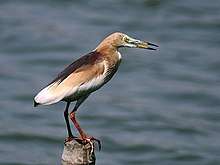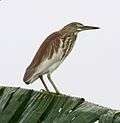Pond heron
Pond herons (Ardeola) are herons, typically 40–50 cm (16–20 in) long with an 80–100 cm (31–39 in) wingspan. Most breed in the tropical Old World, but the migratory squacco heron occurs in southern Europe and the Middle East and winters in Africa. The scientific name comes from Latin ardeola, a small heron (ardea).[1]
| Pond heron | |
|---|---|
 | |
| Indian pond heron (Ardeola grayii) | |
| Scientific classification | |
| Kingdom: | Animalia |
| Phylum: | Chordata |
| Class: | Aves |
| Order: | Pelecaniformes |
| Family: | Ardeidae |
| Genus: | Ardeola F. Boie, 1822 |
| Species | |
| |
These pond herons are stocky species with a short neck, short thick bill, typically buff or brownish back, and coloured or streaked fore neck and breast. In summer, adults may have long neck feathers. Ardeola herons are transformed in flight, looking very white due to the brilliant white wings.
Their breeding habitat is marshy wetlands. They nest in small colonies, often with other wading birds, usually on platforms of sticks in trees or shrubs. Two to five eggs are laid.
These herons feed on insects, fish and amphibians. They are often found on small ponds giving rise to the English name shared by most of the species.
Species
| Image | Name | Common name | Distribution |
|---|---|---|---|
 | Ardeola grayii | Indian pond heron | southern Iran and east to Pakistan, India, Burma, Bangladesh and Sri Lanka |
.jpg) | Ardeola ralloides | Squacco heron | southern Europe and the Greater Middle East. |
 | Ardeola bacchus | Chinese pond heron | China and adjacent temperate and subtropical East Asia. |
| Ardeola speciosa | Javan pond heron | Southeast Asia. | |
_(15224926489).jpg) | Ardeola idae | Malagasy pond heron | Kenya, Tanzania, Uganda, Rwanda and Zambia |
.jpg) | Ardeola rufiventris | Rufous-bellied heron | Angola, Botswana, Burundi, Democratic Republic of the Congo, Kenya, Lesotho, Malawi, Mali, Mozambique, Namibia, Rwanda, South Africa, Swaziland, Tanzania, Uganda, Zambia, and Zimbabwe. |
References
- Jobling, James A (2010). The Helm Dictionary of Scientific Bird Names. London: Christopher Helm. p. 54. ISBN 978-1-4081-2501-4.